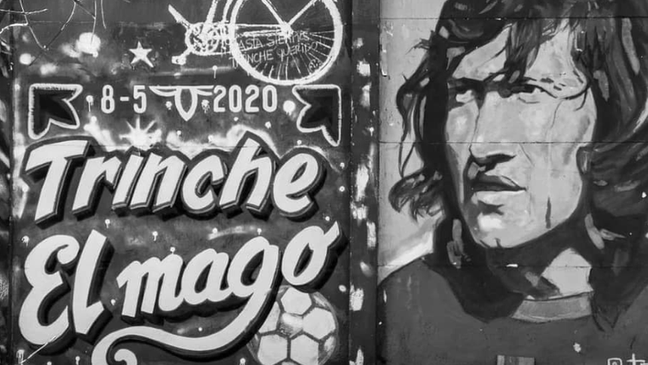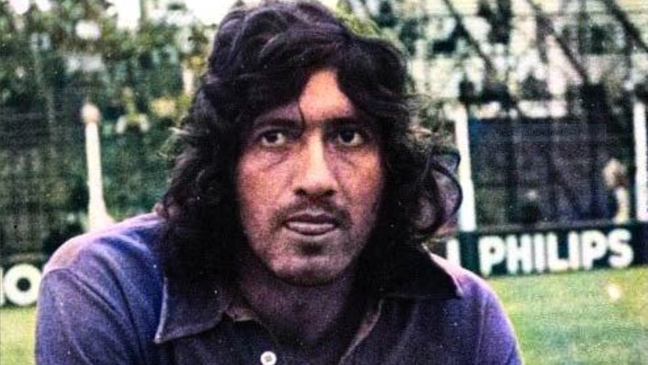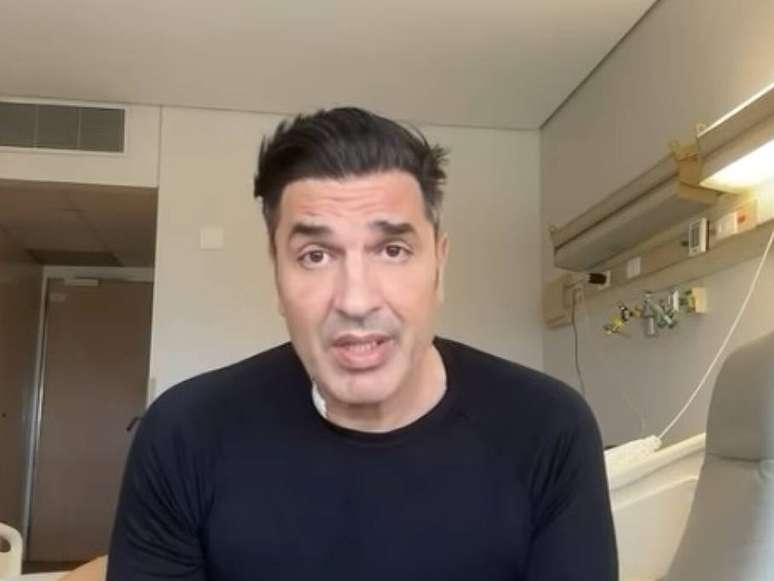Tomás Felipe ‘el Trinche’ Carlovich made just four appearances in the top flight, but a friendly against Argentina made him a legend.

He was a number five in a number 10 left handed jersey.
He only played four games in the first division.
In three of those matches, he was injured.
In the first division he only played for two clubs.
He was a legend.
This is the story of Tomás Felipe “el Trinche” Carlovich, the man to whom Diego Armando Maradona gave a shirt with the inscription “you were better than me”.
the romantic spirit
El Trinche Carlovich was born on April 19, 1946 in Rosario, one of the most footballing cities in Argentina, the birthplace of, among others, Lionel Messi.
He always said he never knew why he was given the nickname that would inevitably replace his two names.

El Trinche played all his life for lower league clubs, including his favorite team, Central Córdoba de Rosario.
“The love they have given me here really touches me,” he said when asked why he hadn’t played abroad, according to Argentine newspaper Clarín.
He has been referred to in many ways: “fairytale character”, “ghost idol”, “skilled bohemian”. A book, a play and dozens of journalistic services were born from his story.
“Carlovich embodies the amateur and romantic spirit of football, that dreamlike stage before professionalism,” Argentine journalist Alejandro Caravario, author of the book, told BBC News Mundo, the BBC’s Spanish-language news service Carve. A journey into the legend of the secret genius of football (“Trinche. A journey into the legend of the secret genius of football”, in literal translation).
To explain this aura of mystery that surrounds the character, Caravario states that “the legend is made up of potential”, and that the myth of this player is full of “what would have happened if…”: if he had been bought by a great club, like River, if he wore the Milan shirt, if he played with Pelé at the New York Cosmos.
To explain why he never consolidated as a player in the first division, those who saw him play also use poetic resources: “he was the last rebel”, “he didn’t want to run without the ball”, “he liked playing football more than being a soccer player”.
He described himself as a loner, “a bit itchy,” who never got anywhere early except for the games.
The relationship with the ball
At the age of 50, Carlovich gave an interview to the journalist Miguel Pisano, of the legendary ElGratico magazine, in which he recalled how he started playing naked on improvised pitches, and also his season in the lower divisions of Rosario Central, where his skill came at a price.
“They spun me like socks. They kicked me to death! I came home exhausted. I never wore shin guards or bandages, as a kid we used to play with our legs until we died.”
For Caravario, El Trinche has never left that phase behind: “I would appeal, in a rather wild way, to psychoanalytic theory,” he told BBC News Mundo, in Argentina, to explain how a player with these characteristics could not stated. the world of football.
“He never got over the infantile phase of his relationship with the ball, that notion of football as a game, and he rejected anything that took him away from the fun of carrying the ball with his feet, such as repetitive training or the obligation to score an adversary”.
At Rosario Central he had his first chance in the first division in 1970, but he played only one game and left the managers in disgust (there are different versions, some attribute his anger to a debt, others to the fact that after that first game did not make him return to the starting lineup).
It would take him another seven years to return to the first division of Argentine football, through the Colón de Santa Fe, in which he was injured in the three games he played.
But the legendary date is April 17, 1974.
That day, the Argentina national team played a friendly match against regional team Rosario in front of an estimated 35,000 people at Newell’s Old Boys Stadium, as part of the buildup to the World Cup in Germany.
Legend has it that due to the “dance” that the regional team was giving to the national team, coach Vladislao Cap asked them to remove the number 5 shirt from the Rosário team to avoid further embarrassment. When he left the field after 60 minutes, the team was already losing 3-0.
“It’s rare that they let you out playing as many as 15 in the second half, so there was something like that,” he told journalist Julián Bricco in an interview many years later about that request.
So close and so far from glory
Carlovich was the only one in that team from Rosario who played in Serie B. As Caravario recounts, “he was the second division player who had to prove himself and he played an extraordinary match”.
The ten other players who took to the field that day were from the first division – five from Newell’s and five from Rosario Central – including Carlos Aimar, Mario Zanabria and Mario Alberto Kempes, who would go on to become the top scorer in the 1978 World Cup.
It was the coach of the 1978 world champion team, César Luis Menotti, who made one of the most famous statements about El Trinche:
“He looked like he was carrying the ball, a smart ball who likes to do artistic things and drags a footballer along with him.”
In 1976, when Carlovich was playing for Independiente Rivadavia, of Mendoza, Menotti called him up for a pre-selection friendly for the World Cup. Legend has it that the player preferred to stay and fish. He denied this version.
Other players in the squad that competed and won the World Cup in Argentina faced El Trinche throughout their careers and years later recalled this midfielder’s skills in El Graph magazine.
“When I played for Sarmiento de Junín, in the lower league, I fell in love with Carlovich. He was the best player I saw before reaching the first division. A star, I wish I was like him,” said Daniel Passarella, captain of the Argentina national team at the World Cup in 1978 and 1982.
“All the coaches I’ve had during my career wanted to include him in their teams, but the skinny guy never wanted to leave Rosario, a real shame,” added Leopoldo Luque.
One of the 1978 champions, goalkeeper Ubaldo Fillol summed up what happened in the 1974 match with two exclamations:
“What a ball they gave us that night! And how that boy played!”
The meeting with Maradona
According to the stories revolving around Carlovich, Milan of Italy wanted to sign him when he played for Independiente Rivadavia, but the story that most contributes to the legend is that Pele himself wanted him at the New York Cosmos.
“He sent letters and everything, but then, all of a sudden, nothing came of it,” El Trinche recalled.
The meeting with the historic number 10 of the Brazilian national team never materialised, but with the legendary number 10 of his country he was luckier.
An article in the Argentine newspaper Clarín recalls that in 1993, when Maradona returned to Argentine football through Newell’s Old Boys, he said he believed he was the best, “but since I arrived in Rosario I have heard wonders from a certain Carlovich, so I don’t know more”.
In February 2020, when Maradona was managing the Gimnasia y Esgrima La Plata team, the two skilled lefties met and “el Trinche” made “el Diego” autograph a Central Córdoba shirt.
“It was a luxury and an enormous joy to share minutes with Diego. I whispered in his ear and told him that it was done, that my life was complete. After meeting him, I can calmly leave,” she said at the time .
And in May of that year he died.
El Trinche was attacked by a man who tried to steal his bicycle in Rosario: the blow to the head first caused a stroke and then his death.
Maradona immediately wrote his last farewell to the player on his social networks:
“With your humility you made us all dance, Trinche. I can’t believe it, I just met you and you’re already gone.”
Maradona would die six months later.
– This text was published in https://www.bbc.com/portuguese/internacional-63833126
🇧🇷The best content in your email for free. Choose your favorite Terra newsletter. Click here!
Source: Terra
Camila Luna is a writer at Gossipify, where she covers the latest movies and television series. With a passion for all things entertainment, Camila brings her unique perspective to her writing and offers readers an inside look at the industry. Camila is a graduate from the University of California, Los Angeles (UCLA) with a degree in English and is also a avid movie watcher.

![New Day ahead: Tera discovers an incredible truth about Gabriel and Audrey … which is waiting for you from the week of 2025 to 18, July 18, 2025 [SPOILERS] New Day ahead: Tera discovers an incredible truth about Gabriel and Audrey … which is waiting for you from the week of 2025 to 18, July 18, 2025 [SPOILERS]](https://fr.web.img5.acsta.net/img/b6/e5/b6e5ddee257bc9a8ae5bb9587db6efc3.jpg)




